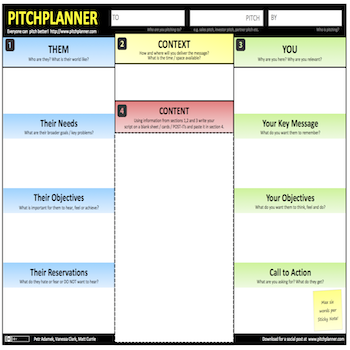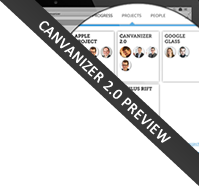PitchPlanner is a Canvas that helps you build and test a pitch script that meets your audience’s needs and generates the outcomes you desire. Whether you are pitching to close an important customer, to get funded by investors, to promote your solution at a tradeshow or conference, to attract a key strategic partner, to build awareness with general public, follow these 12 steps using the pitchplanner.com canvas and Postit notes (or e-version on canvanizer.com) to improve your chances of success! It works for pitches, presentations, media articles, ad scripts, audio and video scripts, landing pages, social posts, etc.
If you want to try it out without entering your email address, please use our public Pitch Planner Canvas for a first impression.

More about the Pitch Planner Canvas
In business, a pitch is a presentation of a business idea to potential investors or presentation of ideas to an audience generally. A pitch is usually done because people need resources for either the execution of business ideas or the fluid operation of the existing business. If the goal of a pitch is to raise cash for the business start-up, then the target of the pitch is an investor. Other businesses pitch to potential customers to sell their products.
PITCH PLANNER CANVAS
Writing a winning pitch script can be difficult because one has to consider different factors relative to the business, the target of the pitch, the content, etc. Pitch Planner Canvas helps to build, organize and test a pitch script that meets your audience’s needs in order to get the desired.
-
THEM = YOUR AUDIENCE:
Who are they? What is their world like? Where are they coming from? What characterises them? Build a simple persona / personas. This column defines the target of your pitch script, if your pitch will be to advertise products to potential customers, you have to identify who your most likely customers are, and how much potential income they represent for your business, you have to understand your audience. Pitching is not only about convincing investors or customers, but you also need to properly identify the audience in order to successfully deliver what they want. -
THEIR NEEDS:
What does your target audience (person) need in the long run? What are they in search of? What is their purpose? What are their broader goals, key long-term issues / problems they face?
You need to understand your target audience; this shows that you understand your audience by defining their needs. You should be realistic about who you’re implementing your idea around This will show your audience that you fully understand what they need, and it will help you think more strategically about your roll-out plan. -
THEIR OBJECTIVES:
What is important for these people to achieve in the short to medium term? How is it related to their long term aspirations? What do they want / expect to hear from you (if anything)? What are the key terms or elements of presented value proposition that may trigger their positive response from them? This defines the objectives of your target audience, what they want to hear or achieve. You can do some research about the target audience before the pitch, this will give you a good sense of what they care about and what their objectives will be. -
THEIR RESERVATIONS:
What do they hate or fear to hear? What are they worried about in relation to their needs and objectives? What phrases or propositions are likely to switch them off or trigger their negative / oppositional response?
These are things your target audience wants to hear, for example, if you are pitching to investors, they want to know about your business’s first set of customers, investments that have been put into the company, key media placement, signed letters of intent to purchase/partner, and so on. Being the chief executive of your own company, you will be expected to be the lead salesperson, you should let the investors know that you know how to sell them on your own company. -
CONTEXT:
Where, and how will the target audience receive your pitch? What are the limitations – time/space available? What is the presentation technology available? What does the space look like? What can go wrong? Context is the background, environment, setting, framework, or surroundings of events or occurrences. Simply, context means circumstances forming the background of your pitch, it communicates your pitch in such a way as to enable the targets of the pitch to understand the narrative or a literary piece. Noting down your context in the pitch planner canvas helps you to communicate clearly and concisely. -
CONTENT:
The content of your pitch script consists of everything about your target audience, the context of your pitch and about you and your team. The content describes everything about your pitch, a successful pitch is determined by how good its content is. -
YOU:
Define the person(s) pitching. Who are they, where do they come from? What makes them relevant to deliver this pitch to this audience? Why this person/team and nobody else? This helps you to properly understand your pitch and your reason for pitching in the first place. This defines your idea, the motivation of the pitch and what you stand to gain. If you are pitching for funds, you need to understand that Investors invest in people first and ideas second, so be sure to share details about yourself and your team and why you are the right person to deliver this solution. -
YOUR KEY MESSAGE:
Define the perception you want to leave with the audience – what do you want them to remember from your pitch after it is over (immediately and in the long run)? What do you want them to be able to say about you/your company/product/solution/dream when asked later by someone who has not been there?
Key messages are the main points you want to communicate as reminders to your target audience. What you want to discuss is headlined by your key message. This can be achieved by starting your pitch with a compelling story. The story should address the problem you’re solving with what you’re pitching. This will engage your audience and that is the importance of a key message. The key message will be even better if you can relate your story to your audience. -
YOUR OBJECTIVES:
What do you want the target audience to think, feel and do after the pitch? Your objectives are what you have in mind for your target audience. It can be your plans to be memorable, answer key questions, make them know more, etc. -
CALL TO ACTION:
This is the definition of your offer and ask. Without offer / ask it is not a pitch, it is just a speech. State clearly what you want the audience to do and what do they get if they do it. This must be clearly coming out of your pitch. In a minimal version of your pitch (one sentence) – this is the only thing you will say!
A call to action is a statement designed to get an immediate response from the person reading or hearing it. It's used in pitching as part of a strategy to get your target audience to respond through action. -
SCRIPT:
Reflecting limitations from 5, take information from 1 to 4 and 6 to 9 above and draft first version of your script on a sheet of paper that you paste in section SCRIPT. -
TEST PITCH:
Find a friendly representative of your target audience. If you do not have one, ask an intelligent friend to pretend they are THEM and listen to you. Simulate the actual delivery as much as you can. Ask them to provide you with feedback about content, clarity, delivery and perceptual objectives (Did they understand? Feel attracted to the offer? Think you are relevant? Would they respond to the call to action? What in their mind works against you? -
LOOP:
Revisit steps 1 to 11. What did you learn from the practice pitch? Do more research on your target audience, experiment with order / flow of your pitch. Add/test emotional hook, shocking fact, plus any relevant pitching hacks! Get rid of non-functioning elements. In 3 iterations of this loop your pitch should be pretty close to your best capability! Good luck!

